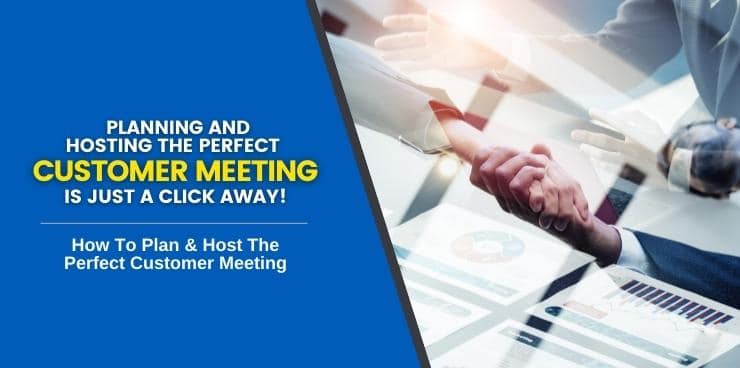A customer meeting is one of the most important events to prepare for in any selling situation. Understanding how to plan and execute a successful sales call will earn your client’s respect and tip the scale toward closing the sale.
However, meeting with clients is easier said than done, and one unproductive meet-up can hurt your relationship or, worse, lose them. So forget everything you think you know about customer meetings. Here, we’ll discuss how to plan professional and strategic customer meetings that build trust, convert, and expand your reach.
Purpose of Each Meeting
Meetings are meant to promote communication and collaboration with clients. Use the time to clarify what your clients need so you can better support them.
But, let’s shatter some common misconceptions.
First: A customer meeting is not always about securing a sale.
False. A client meeting intends to get alignment, agreement, and buy-in. While your sales meeting agenda might not generate revenue, you should always be looking to further the confidence, value, and trust. All of this requires selling.
Second: Customer meetings must be about the customers — not your business, products, or services.
False. While every customer meeting must have your client’s felt needs in mind, at some point you’re going to have to introduce new, interesting, and different information and quite possibly challenge the buyer’s status quo.
For example, instead of saying, “We’d like to give you a demo of our latest HVAC unit so you can see if the features suit your needs,” how about focusing on their advantages by saying, “We believe our new HVAC unit will solve the discomfort you’re experiencing. We’d like to show you how we can take that problem away with ease. How does that sound?”
By reframing the perspective from the “benefits and features” into their “advantages,” you make your clients the hero of the customer meeting. Moreover, asking their permission first demonstrates humility and respect as you give them autonomy and control.
After finalizing your sales meeting agenda, it’s now your responsibility to ensure everything flows smoothly and your client is actively engaged.
If you want to plan and host the perfect customer meeting, Wizard of Sales® can help you make that happen. Book a demo now to learn more!
How Do You Prepare for a Customer Meeting?
1. Do your homework
The internet is an endless source of information; you should learn everything there is to know about your prospect. The more you know the more you limit your vulnerable position of asking the client things that are answerable with one Google search.
Here are some things you should look for online, if possible:
- Biographical history
- Personal interests
- Current focus
- Key challenges
2. Create Your Agenda
Think of your agenda as the roadmap that guides the session into focus. But it’s more than having a clear set of objectives; it’s about answering the question: “What’s in it for them?”
Your sales meeting agenda should reflect what your clients can accomplish by sharing time with you. That said, here are aspects to keep in mind when planning your customer meeting:
- Focus on your customer’s felt needs and how you can help them
- Budget your time and topics in priority
- If possible, share your meeting agenda in advance
3. Examine Your Pitch
Meetings are dynamic. So if you have a sales pitch at hand, make sure to know your product/service inside and out. This will allow you to re-adjust and re-align the features and benefits to tailor-fit the specific advantages your customer is looking to have if they work with you.
4. Prepare Your Questions in Advance
The questions should come along with the preparation of your agenda. These queries are meant to facilitate the customer meeting into uncovering your client’s needs and finding the best solution to help them. We recommend giving clients a questionnaire copy so they can review and prepare, as well.
There are cases when time constraints won’t let you thoroughly discuss. So be decisive enough to punt agenda items when needed.
5. Never Disrespect the Competition
Talking smack about your competitors only makes you look insecure and threatened by them, and that’s a bad look in the eyes of customers. It’s not that you should leave them be. You shouldn’t.
Praise competitors for what they do well, but point out why your company is worth choosing over others.
6. Hold a Mock Meeting
Mock meetings are meant to prevent avoidable delays. If the customer meeting is in person, check that everything works and all tools you need are available. On the other hand, if it’s a video call make sure the conference platform is functional. This ensures that the meeting is spent on working, not fixing technical problems.
7. Confirm Your Meeting Place
Agree on a meeting place at least a week before the actual meet-up and confirm that any reservations or conference links are ready prior.
8. Get Enough Sleep
The importance of sleep can never be understated. Expert negotiators need adequate sleep so emotions and mental functions are at their best. Sleep-deprived people are likely to make bad judgment calls at crucial moments.
9. Get Inspired
Read or watch as many helpful resources as you can that will ensure the success of your customer meeting.
Best Practices in Hosting A Customer Meeting
1. Avoid unnecessary delays
Don’t dwell too much on introductions. Respect your client’s time by getting straight to each point, especially if you have time constraints. Moreover, ensure all preparations are in place during the mock meeting, so there will be no technical difficulties at the meeting proper.
But always remember to pace the conversation appropriately. Consistently ask relevant questions to keep the flow active, but know when to transition from point A to B.
2. Manage the meeting logistics
Once the meeting is set and everyone’s on a green light with the time, place, and communication channels — as the host, let everyone involved know any logistical requirements. For example:
- If it’s a product demonstration: Ask one of your technicians to come along so they can better explain the features
- If it’s a video conference: Share a functioning meeting link with everyone and inform them beforehand if they need to install any software prior
- If it’s an in-person meeting: Provide navigation directions or any security or parking information they should know
Once the logistics are in place, you can now set the perfect conditions with all the right setup and the best possible environment. This will build your managerial skills’ reputation with your client and help you run a successful meeting.
 3. Focus on Your Customer
3. Focus on Your Customer
As the name suggests, the customer meeting is about your customers. Your main goal is to reveal their preferences and unmask any challenges they face, so you can serve them better.
If you notice an inevitable objection coming up, preempt by handling it before the customer does. For example: “I’ve heard customers say our HVAC units are expensive, but…” Admitting the “pros” and “cons” willingly increases your credibility as a company.
4. Set Your Agenda
The initial kickoff of your meeting should focus on keeping the meeting agenda in perspective. Give a brief rundown of the things you will discuss during the meeting so everyone is in the right frame of mind.
When you notice the discussion deviating from the agenda, guide it back to the right flow so no one’s time is wasted. Conversely, when time constraints are encountered, cross-out any agenda points that both parties can forego.
5. Keep Everyone Involved in the Conversation
If you happen to drive the customer meeting, you may be forced to speak a lot and eliminate dead air. But don’t let a minute go by where you’re taking the reins on conversation as your clients may get bored and zone out.
Always engage your customers by consistently asking relevant, open-ended questions to learn more about their problems. And when they speak, really stop and listen as that’s one way to build a solid customer rapport.
Also, make sure to present to everyone by maintaining eye contact and addressing specific people every now and then.
6. Recap Important Points
A good structure before ending a customer meeting is to revisit some of the major points discussed. This will help you assign responsibilities for upcoming tasks and set timelines when plausible. Doing so demonstrates that you respect any decisions made during the conversation, and that you’re willing to comply moving forward.
 7. End Meeting with a Pleasing Climax and Confirm Next Steps
7. End Meeting with a Pleasing Climax and Confirm Next Steps
The best way to conclude a customer meeting is on a high note. Show your enthusiasm about any progress you made and set everyone’s sights on the bright future ahead while you go over the action steps. This builds up their eagerness to move forward with you.
If you earned the customer’s trust, piqued their interest, and eased their pain points — it will be very easy to close or move the sales process further. While you may want to bring up their “buying time frame” if they can’t come to a decision at the moment.
In any case, the extent of the meeting doesn’t end there as there are post-meeting actions you will still have to do.
Post-meeting Actions
Post-meeting Analysis
There’s one Chinese proverb that stuck out to me regarding post-meeting analysis, and I think it will serve you well too.
“The palest ink is better than the best memory.”
Consolidating all information discussed into a form you may retrieve later on is best done right after the meeting. But on top of that, assess the customer meeting if it fulfilled the goal and expectations you initially set, for example:
- Were the meeting’s results successful and was the purpose met?
- Was the meeting well-planned and flawlessly executed?
- Were the meeting’s tone, flow, and participation level positive?
- Were all challenges and problems uncovered and dissected?
- Were all action steps documented and clear?
Follow-up
Follow customer meetings up by sharing your notes via email with the people involved. Craft your notes in accordance with the agenda. It’s best to provide more substantial background information on each section and include all decisions plus action steps you agreed upon.
For the action step, list down the person responsible and insert a deadline for completion. For example:
“Great meeting today! George will reach out on Thursday to schedule an on-site inspection of your system.”
This will keep everyone enthusiastic and looking forward to the next meeting or checkup. Like the customer meeting, end the follow-up by expressing a high note and describing how the session helped your relationship.
Planning and hosting the perfect customer meeting is simple, but not always easy, but with the right guiding principles it can be manageable and a fun experience. If you’re looking to plan and execute the best customer meeting, book a demo with Wizard of Sales® now!



 3. Focus on Your Customer
3. Focus on Your Customer 7. End Meeting with a Pleasing Climax and Confirm Next Steps
7. End Meeting with a Pleasing Climax and Confirm Next Steps